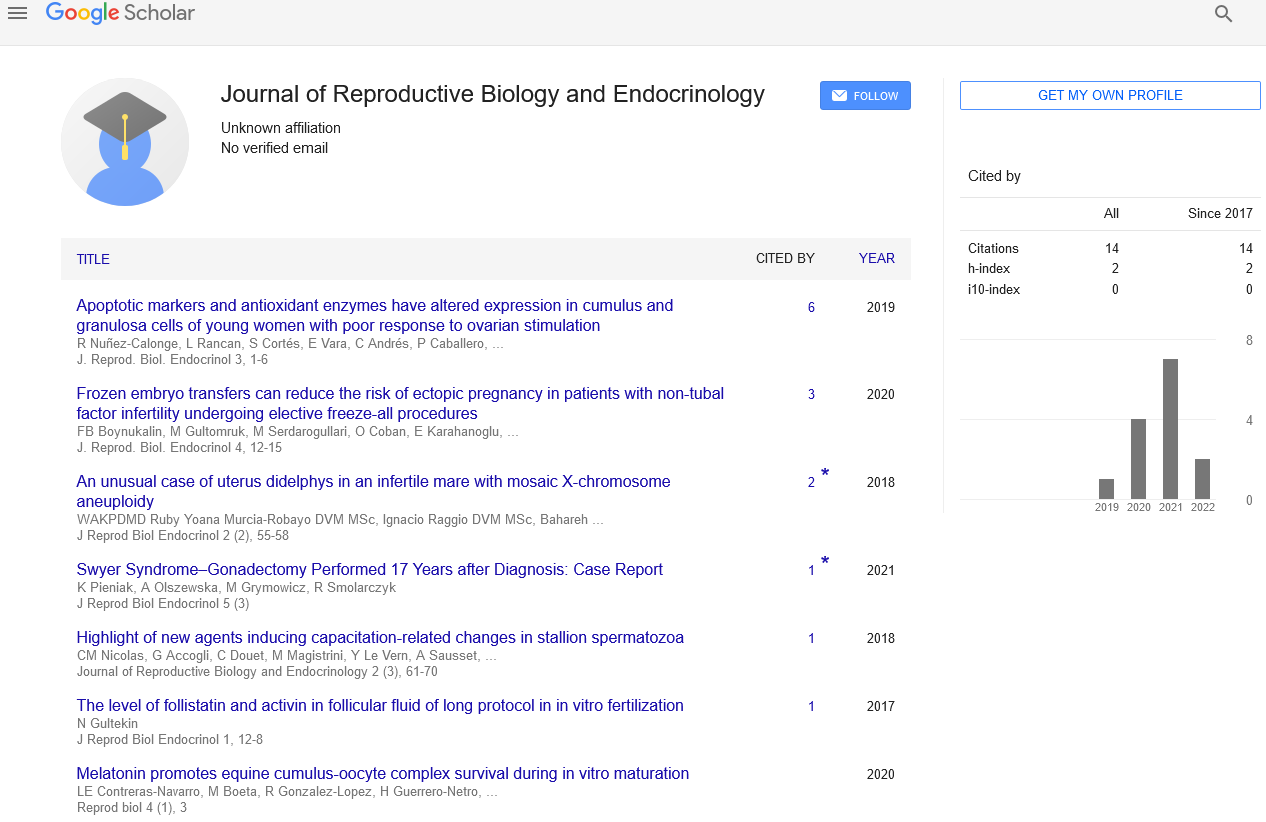Enhancement of metabolic disorders in women with polycystic ovary syndrome
Received: 03-Nov-2021 Accepted Date: Nov 17, 2021; Published: 24-Nov-2021, DOI: 10.37532.21.5.6
Citation: Citation: Ana De Souza, Enhancement of metabolic disorders in women with polycystic ovary syndrome. J Reprod Biol Endocrinol. 2021;5(6):2
This open-access article is distributed under the terms of the Creative Commons Attribution Non-Commercial License (CC BY-NC) (http://creativecommons.org/licenses/by-nc/4.0/), which permits reuse, distribution and reproduction of the article, provided that the original work is properly cited and the reuse is restricted to noncommercial purposes. For commercial reuse, contact reprints@pulsus.com
Polycystic ovary disorder (PCOS) is the foremost common endocrinopathy among regenerative age ladies. In spite of the fact that its cardinal appearances incorporate hyperandrogenism, oligo/anovulation, and/or polycystic ovarian morphology, PCOS ladies frequently show moreover eminent metabolic comorbidities. An cluster of pathogenic mechanisms have been ensnared within the etiology of this heterogeneous endocrine clutter; hyperandrogenism at different formative periods is proposed as a major driver of the metabolic and regenerative irritations related with PCOS. Be that as it may, the current understanding of the pathophysiology of PCOS-associated metabolic malady is fragmented, and helpful procedures utilized to oversee this syndrome’s metabolic complications stay restricted.
Androgen abundance plays a noticeable part within the advancement of metabolic unsettling influences related with PCOS, with a perceivable affect on key fringe metabolic tissues, counting the fat, liver, pancreas, and muscle, and exceptionally noticeably the brain, contributing to the group of stars of metabolic complications of PCOS, from corpulence to affront resistance. In any case, the current understanding of the pathogenic parts of hyperandrogenism in metabolic brokenness of PCOS and the basic instruments stay generally deficient. In expansion, the advancement of more proficient, indeed personalized helpful techniques for the metabolic administration of PCOS patients holds on as an neglected require that will certainly advantage from distant better;a much better;a higher;a stronger;an improved”>a higher comprehension of the atomic premise of this heterogeneous disorder[1, 2].
Polycystic ovary disorder (PCOS) is the foremost predominant endocrine clutter among premenopausal ladies. All inclusive, the rate of this disorder shifts, extending from 6% to 20% depending on the demonstrative criteria connected, with higher predominance in overweight or hefty ladies and in particular ethnic groups . PCOS could be a complex and heterogeneous endocrinopathy characterized by a star grouping of side effects and clinical highlights, counting hyperandrogenism (clinical or biochemical), ovarian brokenness (menstrual abnormalities), and polycystic ovarian morphology. Importantly, 70% of ladies in this later consider were undiscovered. Whereas the upper restrain of predominance for this ponder was ascribed utilizing gauges of polycystic ovaries (PCO) for ladies who had not had an ultrasound, non-imputed prevalences were calculated as 11.9 ± 2.4% . PCOS has too been famous to influence 28% of unselected hefty and 5% of incline ladies. In 2006, based on US information and customarily lower predominance gauges the expected financial burden of PCOS in Australia was AU$400 million (menstrual brokenness 31%, fruitlessness 12% and PCOS-associated diabetes 40% of add up to costs), speaking to a major wellbeing and financial burden [8]. With respects to richness, the assessed taken a toll per birth in overweight Australian ladies with PCOS is tall. Promisingly, way of life mediation comprising dietary, work out and behavioral treatment moves forward richness and diminishes costs per birth essentially.
Until recently no generally acknowledged clinical definition existed for PCOS. Over the past three decades, investigate has highlighted that PCOS may be a heterogeneous condition. Indications and signs related to PCOS have been assessed and the introductory NIH symptomatic criteria based on oligomenorrhoea/amenorrhoea and clinical or biochemical hyperandrogenism have been broadened within the 2003 Rotterdam or ESHRE/ASRM criteria to incorporate PCO at ultrasound within the key demonstrative criteria . A add up to of 25% of youthful ladies have PCO on ultrasound and the incorporation of PCO in demonstrative criteria has expanded the predominance of PCOS. Later information shows that the predominance of PCOS may be multiplied on utilize of the ESHRE/ASRM criteria with a predominance of 12% (not ascribing nearness of polycystic ovaries) to 18% (ascribing nearness of polycystic ovaries) detailed in a community test[3].
The Androgen Abundance PCOS Society proposed encourage adjustment of the demonstrative criteria to avoid those without indications (PCO on ultrasound and oligomenorrhoea/amenorrhoea but no hyperandrogenism). It ought to be famous that PCOS may be a determination of avoidance and conditions counting thyroid brokenness and hyperprolactinaemia ought to be avoided biochemically, while more uncommon conditions ought to be avoided clinically (Cushing’s disorder, virilising tumors, and so on). Be that as it may, cardiometabolic highlights and affront resistance are not currently part of the PCOS symptomatic criteria. Usually in portion inferable to the need of exact strategies to degree affront resistance with estimation not as of now prescribed in clinical hone[4] .
REFERENCES
- Azziz R, et al. The prevalence and features of the polycystic ovary syndrome in an unselected population. J Clin Endocrinol Metab. 2004;89:2745-2749.
- March WA, et al. The prevalence of polycystic ovary syndrome in a community sample assessed under contrasting diagnostic criteria. Hum Reprod. 2010;25:544-551.
- Palioura E, Diamanti-Kandarakis E Industrial endocrine disruptors and polycystic ovary syndrome".Journal of Endocrinological Investigation.2013;36): 1105-1111.
- Oeger KM Developmental origins and future fate in PCOS".Seminars in Reproductive Medicine. 2014;32:157–158.





